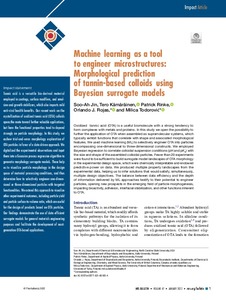| dc.contributor.author | Jin Soo-Ah | |
| dc.contributor.author | Rojas Orlando J. | |
| dc.contributor.author | Rinke Patrick | |
| dc.contributor.author | Todorovic Milica | |
| dc.contributor.author | Kämäräinen Tero | |
| dc.date.accessioned | 2022-10-28T13:25:20Z | |
| dc.date.available | 2022-10-28T13:25:20Z | |
| dc.identifier.uri | https://www.utupub.fi/handle/10024/165066 | |
| dc.description.abstract | Oxidized tannic acid (OTA) is a useful biomolecule with a strong tendency to form complexes with metals and proteins. In this study we open the possibility to further the application of OTA when assembled as supramolecular systems, which typically exhibit functions that correlate with shape and associated morphological features. We used machine learning (ML) to selectively engineer OTA into particles encompassing one-dimensional to three-dimensional constructs. We employed Bayesian regression to correlate colloidal suspension conditions (pH and pK(a)) with the size and shape of the assembled colloidal particles. Fewer than 20 experiments were found to be sufficient to build surrogate model landscapes of OTA morphology in the experimental design space, which were chemically interpretable and endowed predictive power on data. We produced multiple property landscapes from the experimental data, helping us to infer solutions that would satisfy, simultaneously, multiple design objectives. The balance between data efficiency and the depth of information delivered by ML approaches testify to their potential to engineer particles, opening new prospects in the emerging field of particle morphogenesis, impacting bioactivity, adhesion, interfacial stabilization, and other functions inherent to OTA. | |
| dc.language.iso | en | |
| dc.publisher | SPRINGER HEIDELBERG | |
| dc.title | Machine learning as a tool to engineer microstructures: Morphological prediction of tannin-based colloids using Bayesian surrogate models | |
| dc.identifier.url | https://link.springer.com/article/10.1557/s43577-021-00183-4 | |
| dc.identifier.urn | URN:NBN:fi-fe2022081154320 | |
| dc.contributor.organization | fi=materiaalitekniikka|en=Materiaalitekniikka| | |
| dc.contributor.organization-code | 2610202 | |
| dc.converis.publication-id | 174733582 | |
| dc.converis.url | https://research.utu.fi/converis/portal/Publication/174733582 | |
| dc.identifier.eissn | 1938-1425 | |
| dc.identifier.jour-issn | 0883-7694 | |
| dc.okm.affiliatedauthor | Todorovic, Milica | |
| dc.okm.discipline | 114 Fysiikka | fi_FI |
| dc.okm.discipline | 216 Materials engineering | en_GB |
| dc.okm.discipline | 216 Materiaalitekniikka | fi_FI |
| dc.okm.discipline | 114 Physical sciences | en_GB |
| dc.okm.internationalcopublication | international co-publication | |
| dc.okm.internationality | International publication | |
| dc.okm.type | Journal article | |
| dc.publisher.country | Saksa | fi_FI |
| dc.publisher.country | Germany | en_GB |
| dc.publisher.country-code | DE | |
| dc.relation.doi | 10.1557/s43577-021-00183-4 | |
| dc.relation.ispartofjournal | MRS Bulletin | |
| dc.year.issued | 2022 | |
